Projects
TV History
Equipment for sale
Projects
Links and information
|
Unit 23 (formerly BBC LO23-CMCR54)
LO23/CMCR54 was one of the Type 7 units built for the BBC around 1990/91. They were intended as relatively small (4 to 6 cameras) units for smaller scale events and regional use, or to assist at large OBs as a second unit. Facilities included a VT edit suite and 24 channel sound desk. They were built by Smiths of Great Bentley on an ERF E Series chassis, with Cummins 6 litre turbo engine and Eaton 9 speed all synchro range change gearbox.
They were originally all analogue, with a GVG 100 vision mixer and Sony BVP370 or BVP7 cameras. In 1999 Unit 23 (The BBC dropped the geographical designations for the vehicles when all OBs were transferred to Kendal Avenue) was refitted with digital 16:9 equipment, and a 48 channel Innovason digital sound desk. This was mainly for the 'Songs of Praise' contract, but Unit 23 was to do far more than this.
When BBC OBs finally closed and all equipment sold to independent company SIS, the fleet was all re-badged in SIS livery but retained the 'Unit' numbers.
It was decided that it was no longer required in 2013, and was stripped of some of the up to date digital equipment, including the sound desk, and sold for scrap only days before I heard about it. I was put in touch with the scrap merchant, and a deal was struck to save one of the last 'proper' BBC OB trucks from the cutting torch.
There is a lot of work to do, but the vehicle was still on the road and was driven up from near Heathrow.
|
 |
Television Production Equipment Collection
Find out more |
We already have some information on the history of Unit 23 in service, but would be interested to see any more photographs.
After careful examination and talking with several of the former crew, we have decided to restore the vision and VTR sections to their serial digital condition as it was. This has been considerably aided by the purchase of some of the original equipment from the auction of SIS plant held in mid 2014, and much help from people who worked on it until quite recently.
The sound section is to be restored to as near to the original analogue set-up as possible, using the Calrec sound desk from sister vehicle LO24. This will be more challenging than the vision side, as extensive mods were made when the digitisation was carried out.
The vehicle itself needed some fairly major repairs to the metalwork underneath, and then the bodywork has been restored and re-painted in the original BBC livery of light grey/blue.
Two Ikegami HK 388W cameras were bought the former Granada studios at Quay Street, and after the purchase of 3 more 388P cameras (originally from GTV's London Studios) we have a full camera complement. All are 16:9 with SDI output.
WANTED: Any spare parts for the Ikegami 388/ 388P. Viewfinders, lens controls, OCPs. Also wanted urgently- Canon Digisuper 21 focus controls or shot boxes for the 388W.
|
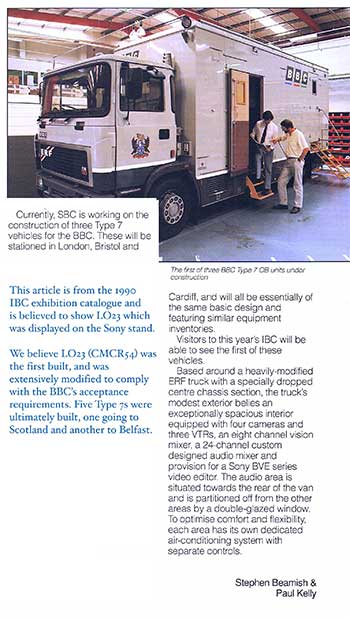
|
| |
Lo23 at the Cutty Sark in Greenwich, London Marathon (1991,2 or 3-Picture-Andrew Brown) |

|
| |
At Wimbledon in 1992. This event was always a major OB with many vehicles involved. (Picture- Steve Challes) |
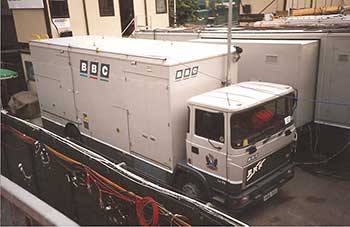
|
At Bristol Cathedral in 1994, the programme was 'A Priest for our Time', the ordination of the first British female Anglican Priests. 32 were ordained at a special service. (Picture- Steve Challes) |
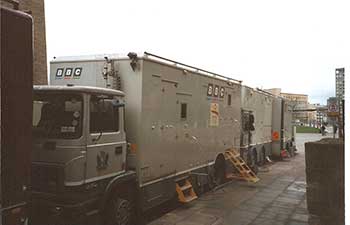 |
| |
At Putney for the 144th Oxford v Cambridge'Boat Race' in 1998, for 'Grandstand'. (Picture-Steve Challes)
This is the next livery used by BBC OB'. Following John Birt's 'Producer Choice' ,'BBC Resources' was split off and had to compete for contracts with the producers. This sort of disasterous 'initiative' was the beginning of the end across the TV industry, and would eventually mean the end of BBC OB's.
At this stage the vehicles were adorned with marketing-style graffiti trying to sell their services. The BBC reduced to begging for work in the streets, while letting the competition in to undercut them.
|
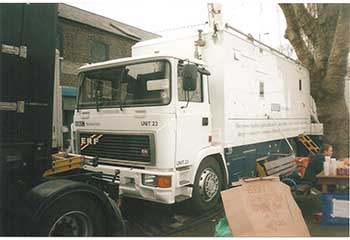 |
| |
At Windsor for Prince Edward's Wedding in 1999. (Picture- Steve Challes)
One of the first OBs after the 1999 refit, carried out at Manchester, at a (partly) estimated cost of around three-quarters of a million pounds. The majority of the electronics was stripped out, and new SDI cameras, monitors and signal processing were installed. The Calrec 'M series' sound desk was removed and a new French Innovason 48 channel digital desk installed (see below). It was subsequently resprayed without the 'graffiti' and with 'Digital Production Unit' on the rear nearside.
Detailed pictures of the refit- here (not yet!) |
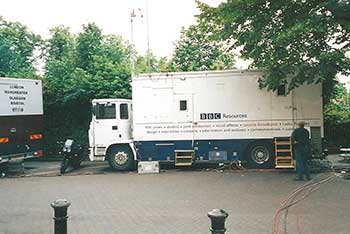 |
| |
Lo23 (now Unit 23) at Glastonbury in 2002. By this time it was all-digital, so the 48 channel Innovason sound desk would have been an advantage for music programmes such as this. (Picture- Mike Watson)
It was also used regularly on Songs of Praise- a little different in content, but similar technically. The lower photo shows the interior of the sound area in action on S.O.P., in Cockermouth, Cumbria, in February 2010. (Picture- David Taviner)
It is still in BBC livery, but after the respray to white with blue lower section, done after digitisation. The circular pattern on the sides had not yet been put on. |
.jpg)
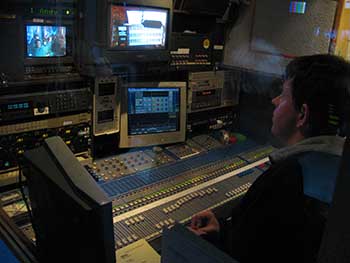
|
| |
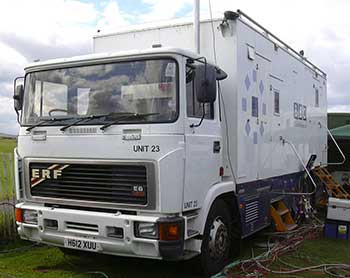
Unit 23 in action at a golf course, sometime later. (Pictures- Brian Summers) |
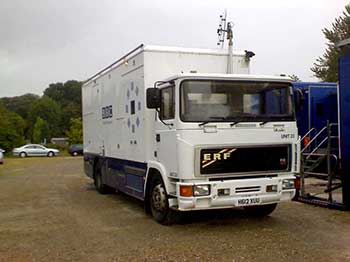 |
| |
Unit 23 outside the Royal Palace in Tblisi for the inauguration of the President of Georgia in 2009! (Picture- Dave Seton)
The BBC identification has been removed, but SIS decals have not yet been fitted.
|
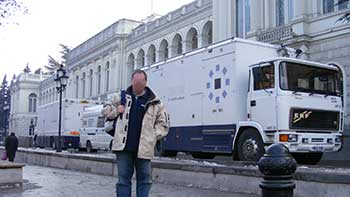 |
| |
At base in Langley with SIS (2009). The BBC identity and circular logos have been remove, and it has been brought into line with the rest of the fleet with SIS logos. (Picture- Robin Stonestreet)
|
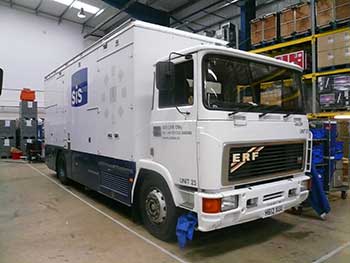 |
| |
Interior of Type 7 (not sure if it is actually Lo23) before refit in 1999. This is the production desk- the vision mixer was a GVG100. Only the talkback units and matrix panels were retained after digitisation. |
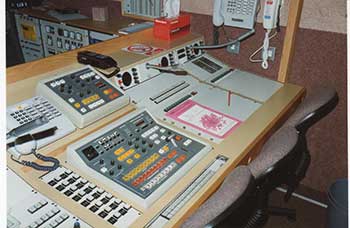 |
| |
The monitor stack before digitisation. Mainly Melford 4:3 monitors. The bottom row are for Vision Control, the production desk is raised so the director and PA are looking over the heads of the vision engineers- the same layout as was used in the old MCRs. |
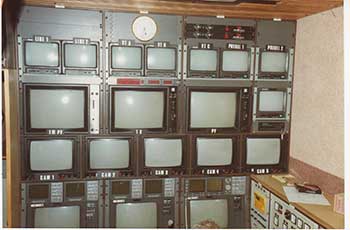 |
| |
Pre-conversion shot of the sound control room (actually Lo24, so the desk is the one that will be installed). Monitor speakers are BBC LS5/9- unfortunately (and unsurprisingly) they had been taken out. I have a pair of ex-BBC Bowers & Wilkins units of about the same size which will do nicely. The support structure had been modified for the conversion, as visible in the picture above. |
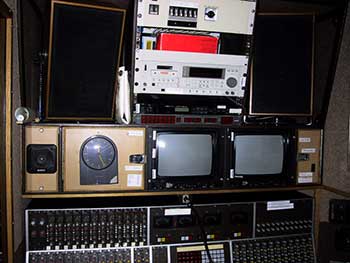 |
| |
The VTR area in use, probably about 2010. A good shot taken during an OB, possibly 'The Great Salford Swim'. 3 Digibetas are in the rack, and there must be an EVR in the 'bookable bay' out of shot, as the control panels are loose on the desk. |
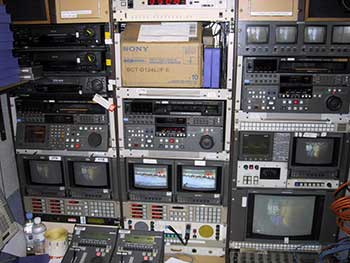 |
| |
In the yard at the SIS Langley base in 2012. Already earmarked for scrap and partly stripped, this was how I first saw it. |
 |
| |
Back at base in Hawarden with it's new friends! |
 |
| |
BBC Resources brochure showing the Type 7 before conversion in 1999 (click images to enlarge) (BBC Copyright) |
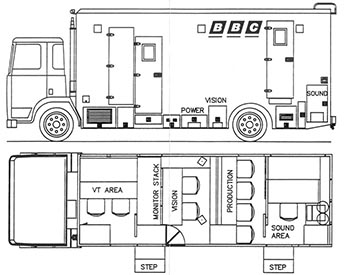 |
BBC Resources brochure showing the Type 7 produced after 1999 (click images to enlarge) (BBC Copyright) |
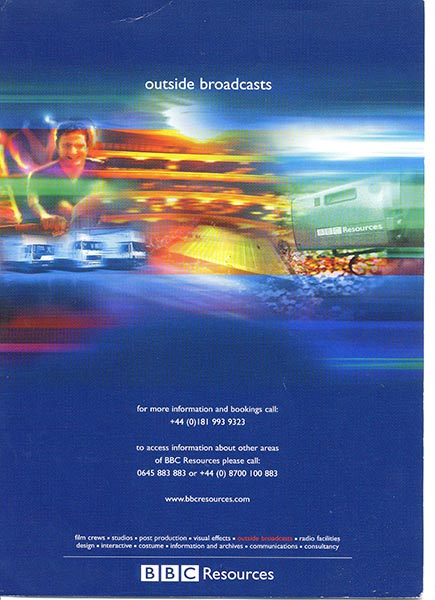 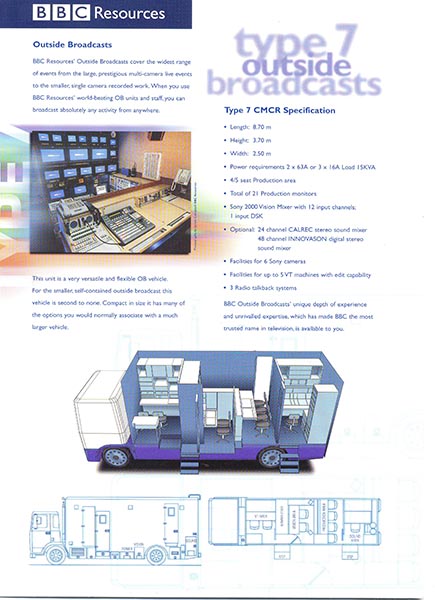 |

